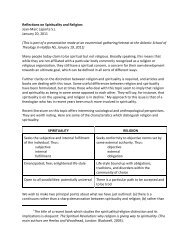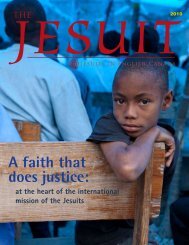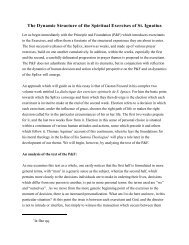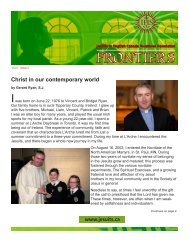Understanding the spiritual journey: from the classical tradition to the ...
Understanding the spiritual journey: from the classical tradition to the ...
Understanding the spiritual journey: from the classical tradition to the ...
You also want an ePaper? Increase the reach of your titles
YUMPU automatically turns print PDFs into web optimized ePapers that Google loves.
How often do we go through this kind of cycle in our lives? More frequently for some, less foro<strong>the</strong>rs. For some <strong>the</strong>se cycles are sharply delineated, for o<strong>the</strong>rs more vague. A person maydwell in one or o<strong>the</strong>r of <strong>the</strong> phases of <strong>the</strong> cycle for a longer time. For some a retreat is <strong>the</strong>beginning of a new cycle, for o<strong>the</strong>rs a way <strong>to</strong> deepen whatever phase of <strong>the</strong> cycle <strong>the</strong> person isexperiencing at <strong>the</strong> time. As we have said, God deals with each individual in a unique way.The analogy of <strong>the</strong> annual liturgical cycle is useful. It is made up of two high points, that ofChristmas which begins with Advent and ends with Epiphany/Baptism, and that of Easterwhich begins with Lent and ends with Pentecost. Between <strong>the</strong>m <strong>the</strong>re is ordinary time.Christians move out of <strong>the</strong>se two intense high-points back in<strong>to</strong> an ordinary experience of beingwith God in daily life. They may have terminated one cycle without yet being in<strong>to</strong> <strong>the</strong> nextcycle, but <strong>the</strong>y continue <strong>to</strong> grow in <strong>the</strong> Lord in <strong>the</strong> quiet way of ordinary time. As we movethrough <strong>the</strong> linear progression of our own lives <strong>to</strong>wards definitive salvation, <strong>the</strong>re may be longperiods of ordinary time.1.5.3 A final remark. We may look upon <strong>the</strong> linear progression of our lives as a whole as amovement <strong>from</strong> purgation/conversion through illumination /sanctification <strong>to</strong> final union,consummated after our death. We may look at <strong>the</strong> repeated cycles of our <strong>spiritual</strong> life in <strong>the</strong>same way. The latter cycles are a reflection, a hologram of <strong>the</strong> former. We are able <strong>to</strong> graspsomething about what happens <strong>to</strong> our lives as a whole whenever we live out a particular cyclewhich has its beginning, its middle, and its end.2 RICHARD OF ST. VICTOR: A TWELFTH CENTURY VARIANTWe have already alluded <strong>to</strong> <strong>the</strong> more practical bent in <strong>spiritual</strong>ity which emerged in <strong>the</strong>Western Church. Richard of St. Vic<strong>to</strong>r was a member of <strong>the</strong> Abbey of St. Vic<strong>to</strong>r, whichflourished in Paris. This was not a typical monastic foundation nestled somewhere in <strong>the</strong> forestwith monks seeking <strong>the</strong> salvation of <strong>the</strong>ir souls in prayer and withdrawal <strong>from</strong> <strong>the</strong> world. It hadan apos<strong>to</strong>lic thrust, especially in <strong>the</strong> intellectual ministry, and played a key role in building upParis as a centre of <strong>the</strong>ological study in medieval Europe. Its members were not monks butcanons regular. 13 Richard was a <strong>spiritual</strong> guide, perhaps a novice master, and prior of his abbey,and wrote abundantly in <strong>the</strong> area of <strong>spiritual</strong>ity.2.1 Richard’s Four Degrees of Violent Love: This is perhaps Richard’s most innovative13 In rough terms, on <strong>the</strong> spectrum of religious life canons regular are found somewherebetween monks and contemporary apos<strong>to</strong>lic religious. They lived a regular life in abbeys, sang <strong>the</strong>office, generally followed <strong>the</strong> Augustinian rule, but differed <strong>from</strong> monks in <strong>the</strong>ir apos<strong>to</strong>liccommitments. Priests in <strong>the</strong> Society of Jesus founded in <strong>the</strong> 16 th century were clerks regular, apos<strong>to</strong>licreligious without <strong>the</strong> obligation of praying <strong>the</strong> office in common.










